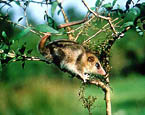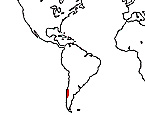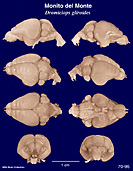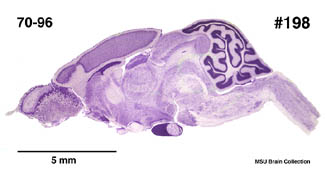|
Monito
del Monte
(Dromiciops gliroides) #70-96 |
||||
|
|
Physical
characteristics and distribution
|
|
Monito
del Monte is believed to be primarily arboreal, though it
my take refuge underground when released from a trap. Nests
are small round structures made of sticks, leaves, mosses
and grasses and can occur under rocks, fallen trees, in tree
hollows, on branches or suspended in lianas. The head and
body length of Monito del Monte is 83-103mm, tail length is
90-132mm and weight is 16.7-31.4 grams. The fur is short,
silky and dense. Upper parts are mostly brown with ashy white
patches on the shoulders and rump. Underparts can be pale.
The semi-prehensile tail is furred but for a narrow strip
25-30mm long on the underside of the tip. They are found in Chile and adjacent Argentina from about 36šS to near 43šS. |
|
Description
of the brain
|
|
The brain weight is 0.97 g. The brain meaurements are: Length AP left 10.8 mm; Length AP right 11.1 mm; Bitemporal width 12.7 mm; Temporal height left 9.3 mm; Temporal height right 8.9 mm. |
|
Animal
source and preparation
|
|
All
specimens collected followed the same preparation
and histological procedure.
|
Other Related Resources (websites and publications)



